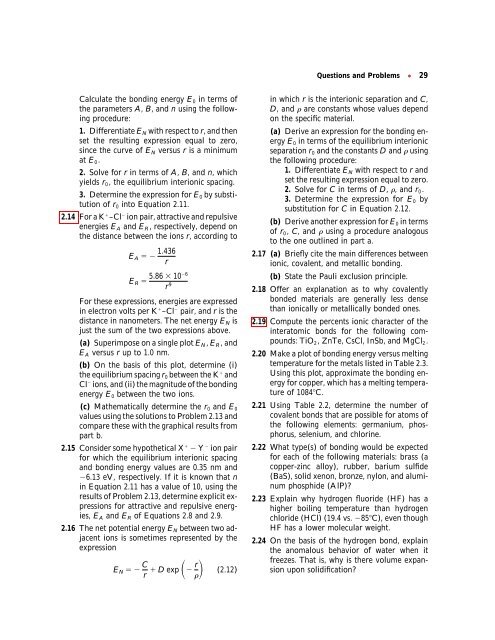Chapter 2 / Atomic Structure and Interatomic Bonding
Chapter 2 / Atomic Structure and Interatomic Bonding
Chapter 2 / Atomic Structure and Interatomic Bonding
You also want an ePaper? Increase the reach of your titles
YUMPU automatically turns print PDFs into web optimized ePapers that Google loves.
Calculate the bonding energy E0 in terms of<br />
the parameters A, B, <strong>and</strong> n using the following<br />
procedure:<br />
1. Differentiate EN with respect to r, <strong>and</strong> then<br />
set the resulting expression equal to zero,<br />
since the curve of EN versus r is a minimum<br />
at E0. 2. Solve for r in terms of A, B, <strong>and</strong> n, which<br />
yields r0, the equilibrium interionic spacing.<br />
3. Determine the expression for E0 by substitution<br />
of r0 into Equation 2.11.<br />
2.14 ForaK –Cl ion pair, attractive <strong>and</strong> repulsive<br />
energies EA <strong>and</strong> ER, respectively, depend on<br />
the distance between the ions r, according to<br />
EA 1.436<br />
r<br />
5.86 106<br />
ER <br />
r9 For these expressions, energies are expressed<br />
in electron volts per K –Cl pair, <strong>and</strong> r is the<br />
distance in nanometers. The net energy EN is<br />
just the sum of the two expressions above.<br />
(a) Superimpose on a single plot EN, ER, <strong>and</strong><br />
EA versus r up to 1.0 nm.<br />
(b) On the basis of this plot, determine (i)<br />
the equilibrium spacing r0 between the K <strong>and</strong><br />
Cl ions, <strong>and</strong> (ii) the magnitude of the bonding<br />
energy E0 between the two ions.<br />
(c) Mathematically determine the r0 <strong>and</strong> E0 values using the solutions to Problem 2.13 <strong>and</strong><br />
compare these with the graphical results from<br />
part b.<br />
2.15 Consider some hypothetical X Y ion pair<br />
for which the equilibrium interionic spacing<br />
<strong>and</strong> bonding energy values are 0.35 nm <strong>and</strong><br />
6.13 eV, respectively. If it is known that n<br />
in Equation 2.11 has a value of 10, using the<br />
results of Problem 2.13, determine explicit expressions<br />
for attractive <strong>and</strong> repulsive energies,<br />
EA <strong>and</strong> ER of Equations 2.8 <strong>and</strong> 2.9.<br />
2.16 The net potential energy EN between two adjacent<br />
ions is sometimes represented by the<br />
expression<br />
EN C<br />
r<br />
D exp (2.12)<br />
r <br />
Questions <strong>and</strong> Problems ● 29<br />
in which r is the interionic separation <strong>and</strong> C,<br />
D, <strong>and</strong> are constants whose values depend<br />
on the specific material.<br />
(a) Derive an expression for the bonding energy<br />
E0 in terms of the equilibrium interionic<br />
separation r0 <strong>and</strong> the constants D <strong>and</strong> using<br />
the following procedure:<br />
1. Differentiate EN with respect to r <strong>and</strong><br />
set the resulting expression equal to zero.<br />
2. Solve for C in terms of D, , <strong>and</strong> r0. 3. Determine the expression for E0 by<br />
substitution for C in Equation 2.12.<br />
(b) Derive another expression for E0 in terms<br />
of r0, C, <strong>and</strong> using a procedure analogous<br />
to the one outlined in part a.<br />
2.17 (a) Briefly cite the main differences between<br />
ionic, covalent, <strong>and</strong> metallic bonding.<br />
(b) State the Pauli exclusion principle.<br />
2.18 Offer an explanation as to why covalently<br />
bonded materials are generally less dense<br />
than ionically or metallically bonded ones.<br />
2.19 Compute the percents ionic character of the<br />
interatomic bonds for the following compounds:<br />
TiO2, ZnTe, CsCl, InSb, <strong>and</strong> MgCl2. 2.20 Make a plot of bonding energy versus melting<br />
temperature for the metals listed in Table 2.3.<br />
Using this plot, approximate the bonding energy<br />
for copper, which has a melting temperature<br />
of 1084C.<br />
2.21 Using Table 2.2, determine the number of<br />
covalent bonds that are possible for atoms of<br />
the following elements: germanium, phosphorus,<br />
selenium, <strong>and</strong> chlorine.<br />
2.22 What type(s) of bonding would be expected<br />
for each of the following materials: brass (a<br />
copper-zinc alloy), rubber, barium sulfide<br />
(BaS), solid xenon, bronze, nylon, <strong>and</strong> aluminum<br />
phosphide (AlP)?<br />
2.23 Explain why hydrogen fluoride (HF) has a<br />
higher boiling temperature than hydrogen<br />
chloride (HCl) (19.4 vs. 85C), even though<br />
HF has a lower molecular weight.<br />
2.24 On the basis of the hydrogen bond, explain<br />
the anomalous behavior of water when it<br />
freezes. That is, why is there volume expansion<br />
upon solidification?



